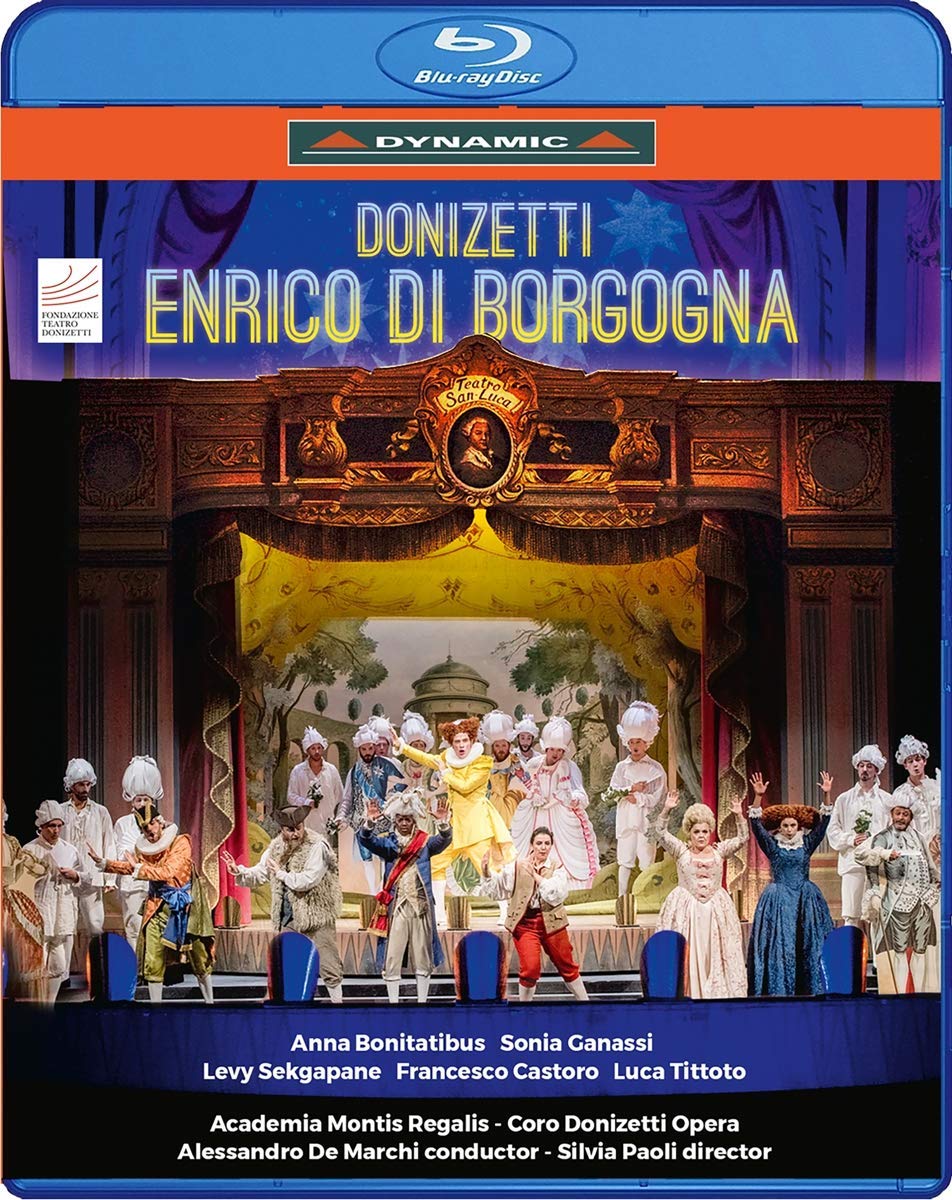DONIZETTI Enrico di Borgogna (De Marchi)
View record and artist detailsRecord and Artist Details
Genre:
Opera
Label: Dynamic
Magazine Review Date: 04/2020
Media Format: Blu-ray
Media Runtime: 160
Mastering:
DDD
Catalogue Number: 57833

Tracks:
| Composition | Artist Credit |
|---|---|
| Enrico di Borgogna |
Gaetano Donizetti, Composer
Academia Montis Regalis Alessandro de Marchi, Conductor Anna Bonitatibus, Enrico, Mezzo soprano Donizetti Opera Chorus Federica Vitali, Geltrude, Soprano Francesco Castoro, Pietro, Tenor Levy Sekgapane, Guido, Tenor Lorenzo Barbieri, Brunone, Bass-baritone Luca Tittoto, Gilberto, Bass Matteo Mezzaro, Nicola, Tenor Sonia Ganassi, Elisa, Mezzo soprano |
Author: Mark Pullinger
When a director turns an opera eroica into a meta-theatrical farce, one has to question whether she happens to believe in the work itself. Reading the plot of Donizetti’s Enrico di Borgogna, I share some sympathy for Silvia Paoli. It’s standard bel canto fare. Young Enrico, raised as a shepherd, discovers he is the heir to a kingdom. His father was killed by a usurper (Enrico’s uncle), who has himself just died, succeeded by his son, Guido. Enrico plans an assault on the castle, discovering that Guido is about to marry Elisa, whom Enrico also loves. Fortunately, things work out for a happy ending.
So what does Paoli do with Enrico at Bergamo’s Donizetti Festival? She turns it into a ‘theatre within a theatre’ show. It’s November 1818 and the cast and crew are about to stage … Enrico di Borgogna. The prima donna is throwing a strop and the singer of the title-role, Fanny Eckerlin, has gone awol. In desperation, the impresario shoves a young seamstress on to the stage, score in hand, to sing Enrico instead. She does – triumphantly – because said seamstress is Anna Bonitatibus and bel canto is what she does best.
Bonitatibus’s softly bronzed mezzo is wonderfully agile, her technique superb in Enrico’s florid opening cavatina ‘Care aurette che spiegate’. Her coloratura is even but never showy. Why she’s not a superstar of the operatic firmament is anyone’s guess. Sonia Ganassi, another mezzo, sings Elisa well, although her larger instrument is occasionally unwieldy. She and Bonitatibus blend well in their pearl of a duet in Act 2. Levy Sekgapane takes on the role of the tyrant, Guido. His high notes have a bright, metallic sheen (Rossini tenor roles are his forte) but there are some heavy aspirates too. The rest of the cast aren’t quite up to this level but are reliable. Alessandro De Marchi conducts the period band Academia Montis Regalis with verve.
Paoli’s production, as you’d imagine, doesn’t take itself too seriously and is a lot of fun as a result, such as the extra in a bear costume who pops up comically in various ‘serious’ scenes. Singers – including the bear – strike silly poses in the Act 1 finale as the impresario frantically tries to shift the scenery for Act 2. Before the finale, the chorus ‘Crush him! Kill him!’ switches focus to the impresario, as they try and extract their wages from him, while halfway through Enrico’s closing rondo cast and crew depart – eager to get home – leaving Bonitatibus singing her heart out on an empty stage. Not perhaps what Donizetti intended, but it does the job very well indeed.
Discover the world's largest classical music catalogue with Presto Music.

Gramophone Digital Club
- Digital Edition
- Digital Archive
- Reviews Database
- Full website access
From £8.75 / month
Subscribe
Gramophone Full Club
- Print Edition
- Digital Edition
- Digital Archive
- Reviews Database
- Full website access
From £11.00 / month
Subscribe
If you are a library, university or other organisation that would be interested in an institutional subscription to Gramophone please click here for further information.




